Why German tanks were gas-powered
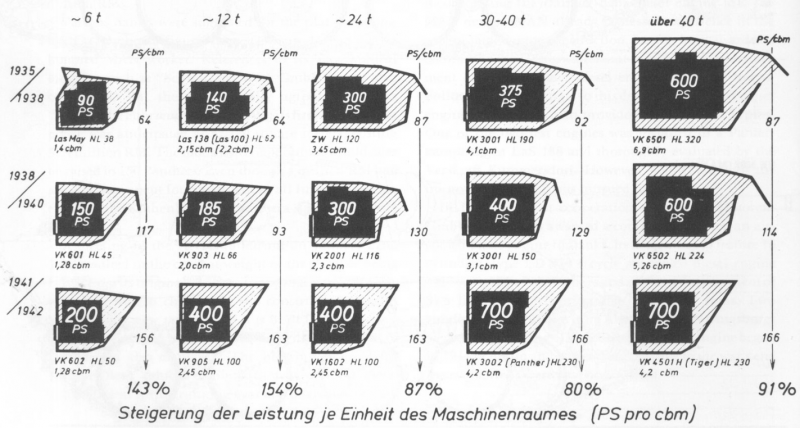
The development of German gasoline engines on tanks. Power grew without increasing armor volume in all weight classes. Source: Walter Spielberger
It is known that almost all German armored vehicles during the Second World War ran on gasoline. And although you can find rare diesel models, all serial tanks and the famous half-track tractors were gasoline. This begs the question: why did the Germans not work out with diesels on armored vehicles? It was the Germans who created the diesel engine and set up mass production of Junkers diesel aircraft, although at that time it was a difficult task. And against the background of these achievements - totally gasoline tanks. What's the matter?
Attempts to find the answer gave rise to a number of myths. Here are typical explanations: the Germans, they say, could neither create their own tank diesel engine, nor copy the B-2; they synthesized gasoline from coal, and all diesel fuel was "eaten" fleet; they preferred gasoline engines to unify fuel and simplify logistics. In this article, we will go through all these points, consider German tank diesel engines and give the floor to the Germans themselves.
Did the fleet "ate" everything?
The Germans' fascination with gasoline tank engines is often explained by the fuel balance: the industry provided synthetic gasoline, and all the diesel fuel allegedly went to the fleet. This is not entirely true, or rather, not at all.
The Germans synthesized from coal not only gasoline, but also diesel fuel, fuel oil and even lubricating oils. In the first quarter of 1944, at the peak of production, they synthesized 315 tons of regular gasoline, 200 tons of diesel fuel and 222 tons of fuel oil. During interrogations, German experts said that before the war, synthetic gasoline was considered more affordable, but since 1942 the situation began to change. It was then that the army began to advocate for diesel engines much more actively.
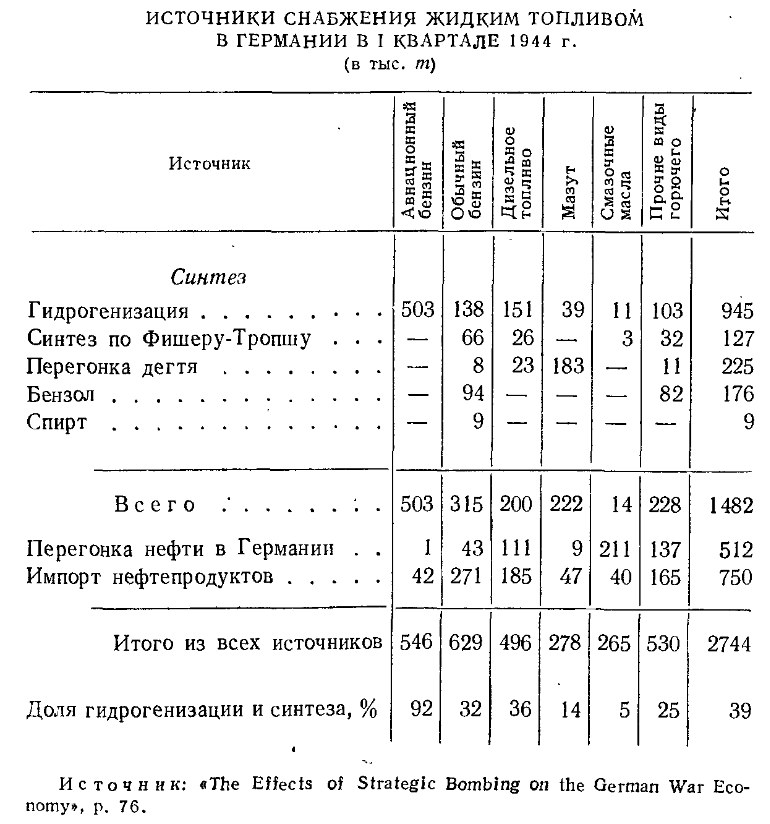
Fuel synthesis in 1944. Source: German industry during the war 1939–1945 Ed. Sogomonyan G.S. - M .: "Foreign Literature", 1956
It cannot be said that all diesel fuel went to the fleet. During the war years, the Wehrmacht received about 150 diesel trucks. The single army truck Einheits-Diesel, as the name suggests, was diesel. In addition, diesel trucks and buses continued to serve in the civilian sector. The Germans even exported a small part of diesel fuel.
Obviously, the Wehrmacht was never completely gas-powered. And if you still need two types of fuel, why not build diesel tanks?
Looking for the best
In the 30s and 40s, German tank building developed centrally. The Arms Department made detailed requirements for the tank and turned to firms with assignments. One company developed the tower, another - the chassis, the third - the engine, and so on. It turns out that the design of the tank was largely determined by the requirements of the Ordnance Department. Or rather, Department No. 6, which dealt with tracked and half-tracked vehicles. This department was headed by the famous engineer Heinrich Knipkamp.
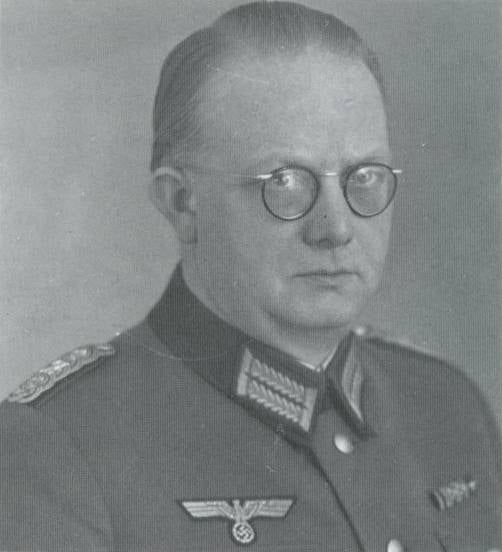
Heinrich Ernst Kniepkamp (1895–1977). Source: Walter Spielberger
At one of the interrogations after the war, Knipkamp told the reasons for choosing engines for tanks. In the first place was the minimum armored volume - the power plant should be compact. Other things being equal, a gasoline engine is lighter and smaller than a diesel engine, but requires better cooling and larger fuel tanks. The military wanted a range of five hours at maximum power, in which case the petrol engine was better. But, as Knipkamp noted, with a power reserve of ten hours, the diesel engine already came out on top.
There were other considerations as well. Kniepkamp favored compact powerful supercharged engines running at high speeds, but subject to adequate reliability. Experience suggested that suitable diesel engines were more difficult to develop and appeared 2-3 years later than gasoline ones. According to Knipkamp, diesels did not have decisive advantages in fire hazard - they still tried to take the fuel tanks out of the fighting compartment. In addition, gasoline engines are easier to start in cold weather.
Daimler-Benz diesels
The Germans first thought about a 700 hp tank engine. With. way back in 1935. They understood that sooner or later they would step over the bar of 30 tons, so they needed a powerful engine “for growth”. In response, Daimler-Benz offered the MB 507 diesel engine. It was available in two versions. The younger one with a volume of 42 liters produced 700 liters. With. for a long time, and the older one with a volume of 44 liters - 800 liters. With. continuously and 1 l. With. on the limit.
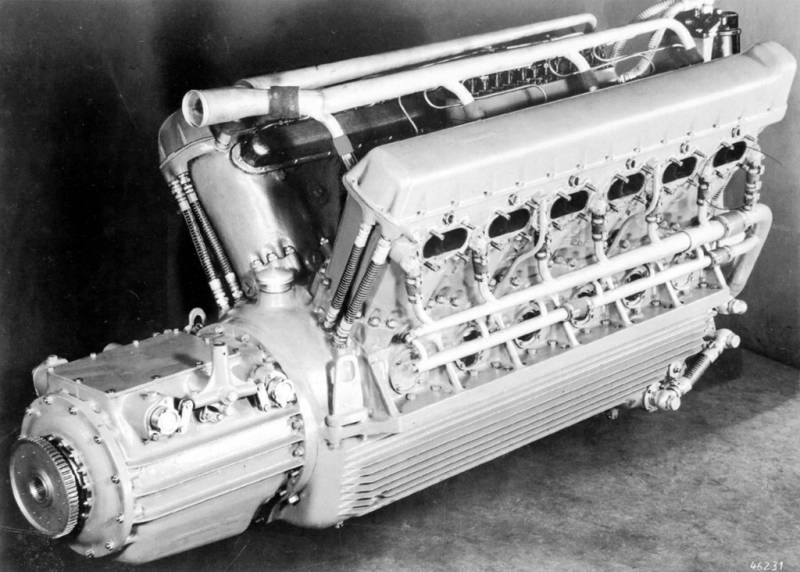
Diesel MB 507. Source: warspot.ru
The MB 507 diesel engine was installed on Karl-Gerät self-propelled mortars and the VK 30.02 (D) experimental chassis - the Daimler-Benz Panther. Its supercharged modification, MB 517 with a capacity of 1 liters. s., hit the second prototype of the Maus super-heavy tank. Note that of the five engines that were offered during the development of Maus, four were diesels. But in general, the military showed little interest in the MB 200 due to its excessive length. The preference was given to more compact Maybach engines, which were very conveniently arranged.
In 1938, Department No. 6 prepared requirements for tank diesels. At the same time, Daimler-Benz began developing the MB 809 diesel engine with an emphasis on compactness and low weight. Engineers evaluated several projects, and in the end they chose the most compact version with a volume of 17,5 liters and a power of 360 hp. With. In terms of weight and dimensions, it was similar to the Maybach HL 120 gasoline engine, but it was more powerful and more economical.
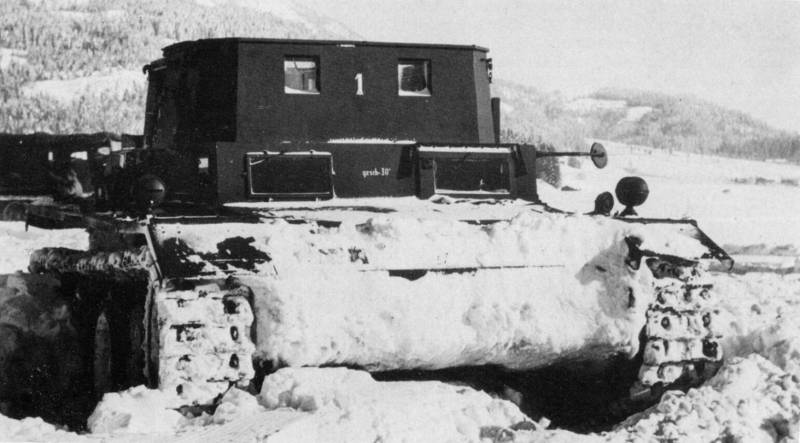
Winter testing VK 20.01 (D). Source: Panzer Tracts
The MB 809 project was ready in June 1940, and in February and March 1941 the first engine was tested. Then it was installed on the VK 20.01 (D) chassis, the first German tank designed with a diesel engine. By January 1945, the prototype had traveled over 6 kilometers. However, in December 1941, after inspecting the Soviet T-34 and KV-1, the Germans decided to switch to tanks of the 30-ton class - the future Panthers. And the 22-ton VK 20.01 (D) was left out of work.
Air cooled vs water cooled
The Ordnance Department preferred water-cooled engines. According to Knipkamp, air cooling requires more labor-intensive production due to the turning of the ribs. If the cylinders with fins are made cast, then the cooling efficiency will decrease, and with it the engine power. Despite this, the Germans also did a lot of air-cooled diesel engines. They had an important advantage for military equipment - the absence of a water radiator. Without it, the engine was more tenacious, at the same time, problems with freezing of water in Russian snowdrifts and its overheating in the sands of Africa were removed.
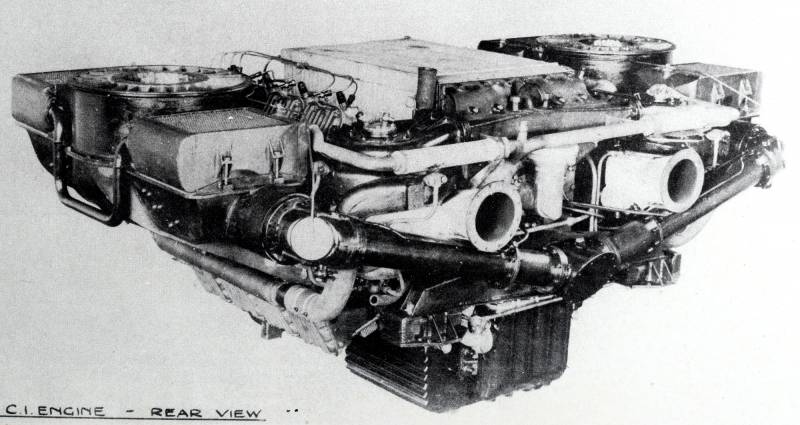
Diesel engine SLa 16 with cooling system. Source: CIOS. The War-time Activities of Dr. Ing. HCF Porsche KG
Air-cooled diesel engines had their supporters, among them Adolf Hitler, State Secretary Karl-Otto Saur and the head of the Tank Commission, Ferdinand Porsche. Since 1942, Porsche and Simmering have jointly developed air-cooled diesel engines with standardized 2,3-liter cylinders and turbocharging. Early designs for the Maus super-heavy tank featured 16-cylinder and 18-cylinder V-diesels with 750–850 hp. With. Narrow and long, they just fit between the very wide tracks. But the Tigers had shorter and wider engine compartments, so an x-shaped 16-cylinder diesel engine with 750 hp was offered for them. With. This project is known as SLa 16.
In 1944, Simmering assembled the first SLa 16 engine. It had a cooling system with two fans and two oil coolers. The tests revealed serious shortcomings, so the project had to be redone. In early 1945, a second engine was completed with four smaller oil coolers. It successfully passed the tests and was installed in the Jagdtiger self-propelled gun in April. The Germans managed to make several test trips for five engine hours, and after that the Soviet troops captured the unique diesel self-propelled gun.
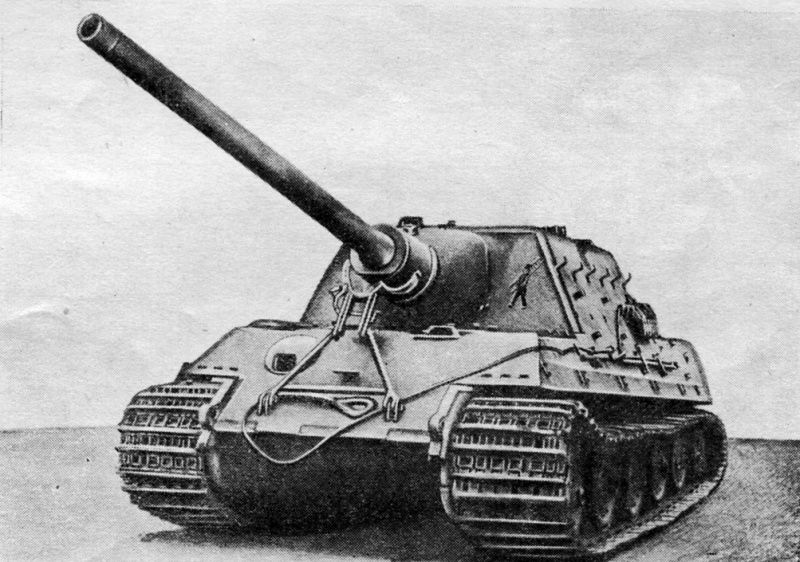
Jagdtiger with SLa 16 diesel engine. Source: Tank Industry Bulletin
In general, story diesel SLa 16 is surrounded by myths. It is often written that it was installed in the "Royal Tiger", and with minimal alterations. In fact, the SLa 16 was tested on the Jagdtiger, which can be identified by the drawing of a chimney sweep. It was installed by the Nibelungenwerke plant, which assembled the Jagdtigers. The makeover was a major one, with a new engine deck and different fuel tanks.
Plans and reality
So far we have been talking about individual prototypes and experimental developments. However, the Germans had quite serious plans for the production of diesel armored vehicles and military tractors. Magirus has launched the production of RSO / 03 tracked tractors with Duetz air-cooled diesel engines. In 1944, the production of an eight-wheeled all-wheel drive armored car Sd.Kfz.234 began with a V-12 Tatra Typ 103 diesel engine with an HP 220 power. With. Note that the installation of an air-cooled diesel engine was stipulated in the requirements back in 1940.
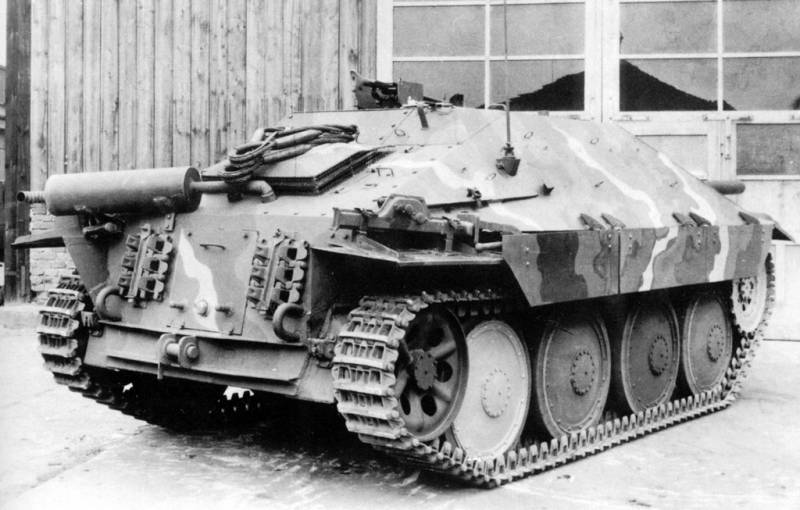
Jagdpanzer 38 starr with diesel engine, April 1945. Source: warspot.ru
The Germans repeatedly discussed the installation of a diesel engine on the Jagdpanzer 38. This idea arose as early as March 1944, when the first self-propelled guns were assembled. On March 29, 1945, General Guderian demanded a switch to the production of diesel Jagdpanzer 38s due to lack of fuel. By April, the Jagdpanzer 38 starr prototype was ready with a rigid gun mount and a 928 hp Tatra Typ 180 air-cooled diesel engine. With. The Germans discussed its serial production, but it was too late.
In September 1944, the Germans decided to start production of the Jagdpanzer 38 with a Tatra diesel at the Alkett factory instead of the StuG III, which was produced there. The Czech project required serious alteration, so Alkett engineers developed a similar Jagdpanzer 38 D self-propelled gun. The Tatra Typ 103 diesel engine, already familiar to us, became its heart. Of course, because of the defeat of Germany, it remained on paper.
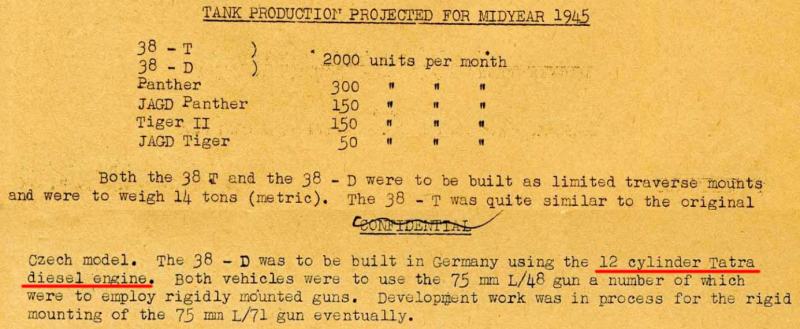
Plans for the production of armored vehicles in 1945. As they say, dreaming is not harmful. Source: Interrogation report of Gerd Stieler von Heidekampf
Even from this brief article, you can see that the Germans were seriously engaged in diesel engines for military equipment. In fact, the topic is much broader. For example, we did not say anything about German two-stroke diesel engines, and it was the Germans who were the first in the world to begin developing a special two-stroke tank diesel engine.
Although the German Ordnance Department, with rare exceptions, preferred armored vehicles with gasoline engines, the development of universal and tank diesel engines went on throughout the war. From 1942, the fuel situation began to change, so by 1945 diesel engines were preferred. If the war had continued for another six months, then the Germans would have managed to establish a mass production of diesel armored vehicles, and then the issue of a gasoline Wehrmacht would disappear by itself.
Sources:
Protocol of interrogation of Gerd Stieler von Heidekampf, June 28, 1945
Protocol of interrogation of Heinrich Knipkamp about engines for military equipment (the date is unknown to the author)
Bulletin of the tank industry No. 7–8 for 1945
Thomas L. Jentz, Hilary L. Doyle. Paper Panzers: Panzerkampfwagen & Jagdpanzer (Panzer Tracts Nr. 20–1) – Panzer Tracts, 2001
Thomas L. Jentz, Hilary L. Doyle. Schwere Panzerkampfwagen Maus and E-100 (Panzer Tracts Nr. 6–3) – Panzer Tracts, 2008
Thomas L. Jentz, Hilary L. Doyle. Jagdpanzer 38 "Hetzer" 1944-1945 - Osprey Publishing, 2001
Thomas L. Jentz, Hilary L. Doyle. Germany's Panther Tanks. The Quest for Combat Supremacy - Schiffer Publishing, 1995
Walter J. Spielberger. Panzerkampwagen IV and Its Variants 1935–1945 - Schiffer Pub. Ltd, 2011
Information